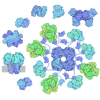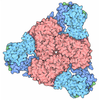+ Open data
Open data
- Basic information
Basic information
| Entry | Database: PDB / ID: 9isb | ||||||
|---|---|---|---|---|---|---|---|
| Title | Ligand bound AGD of enzyme | ||||||
 Components Components | Protein acetyltransferase | ||||||
 Keywords Keywords | TRANSFERASE / Acetyltransferase | ||||||
| Function / homology |  Function and homology information Function and homology informationacyltransferase activity, transferring groups other than amino-acyl groups / ATP binding / metal ion binding Similarity search - Function | ||||||
| Biological species |  | ||||||
| Method |  X-RAY DIFFRACTION / X-RAY DIFFRACTION /  SYNCHROTRON / SYNCHROTRON /  MOLECULAR REPLACEMENT / Resolution: 2.24 Å MOLECULAR REPLACEMENT / Resolution: 2.24 Å | ||||||
 Authors Authors | Park, J.B. / Roh, S.H. | ||||||
| Funding support |  Korea, Republic Of, 1items Korea, Republic Of, 1items
| ||||||
 Citation Citation |  Journal: Proc Natl Acad Sci U S A / Year: 2025 Journal: Proc Natl Acad Sci U S A / Year: 2025Title: Structural basis of the catalytic and allosteric mechanism of bacterial acetyltransferase PatZ. Authors: Jun Bae Park / Gwanwoo Lee / Yu-Yeon Han / Dongwook Kim / Kyoo Heo / Jeesoo Kim / Juhee Park / Hyosuk Yun / Chul Won Lee / Hyun-Soo Cho / Jong-Seo Kim / Martin Steinegger / Yeong-Jae Seok / Soung-Hun Roh /  Abstract: GCN5-related -acetyltransferases (GNATs) are essential for regulating bacterial metabolism by acetylating specific target proteins. Despite their importance in bacterial physiology, the mechanisms ...GCN5-related -acetyltransferases (GNATs) are essential for regulating bacterial metabolism by acetylating specific target proteins. Despite their importance in bacterial physiology, the mechanisms behind their enzymatic and regulatory functions remain poorly understood. In this study, we investigated the structures of protein acetyltransferase Z (PatZ), a Type I GNAT, and examined its ligand interactions, catalytic mechanism, and allosteric regulation. PatZ functions as a homotetramer, with each subunit comprising a catalytic and a regulatory domain. Our results demonstrate that the regulatory domain is vital for acetyltransferase activity, as it triggers cooperative conformational changes in the catalytic domain and directly aids in the formation of substrate-binding pockets. Additionally, a protein structure-based evolutionary analysis of bacterial GNAT types revealed a distinct regulatory domain pattern across phyla, highlighting its crucial role in responding to cellular energy levels. #1: Journal: mBio / Year: 2018 Title: Identification of Novel Protein Lysine Acetyltransferases in Escherichia coli. Authors: David G Christensen / Jesse G Meyer / Jackson T Baumgartner / Alexandria K D'Souza / William C Nelson / Samuel H Payne / Misty L Kuhn / Birgit Schilling / Alan J Wolfe /  Abstract: Posttranslational modifications, such as ε-lysine acetylation, regulate protein function. ε-lysine acetylation can occur either nonenzymatically or enzymatically. The nonenzymatic mechanism uses ...Posttranslational modifications, such as ε-lysine acetylation, regulate protein function. ε-lysine acetylation can occur either nonenzymatically or enzymatically. The nonenzymatic mechanism uses acetyl phosphate (AcP) or acetyl coenzyme A (AcCoA) as acetyl donor to modify an ε-lysine residue of a protein. The enzymatic mechanism uses ε-lysine acetyltransferases (KATs) to specifically transfer an acetyl group from AcCoA to ε-lysine residues on proteins. To date, only one KAT (YfiQ, also known as Pka and PatZ) has been identified in Here, we demonstrate the existence of 4 additional KATs: RimI, YiaC, YjaB, and PhnO. In a genetic background devoid of all known acetylation mechanisms (most notably AcP and YfiQ) and one deacetylase (CobB), overexpression of these putative KATs elicited unique patterns of protein acetylation. We mutated key active site residues and found that most of them eliminated enzymatic acetylation activity. We used mass spectrometry to identify and quantify the specificity of YfiQ and the four novel KATs. Surprisingly, our analysis revealed a high degree of substrate specificity. The overlap between KAT-dependent and AcP-dependent acetylation was extremely limited, supporting the hypothesis that these two acetylation mechanisms play distinct roles in the posttranslational modification of bacterial proteins. We further showed that these novel KATs are conserved across broad swaths of bacterial phylogeny. Finally, we determined that one of the novel KATs (YiaC) and the known KAT (YfiQ) can negatively regulate bacterial migration. Together, these results emphasize distinct and specific nonenzymatic and enzymatic protein acetylation mechanisms present in bacteria.ε-Lysine acetylation is one of the most abundant and important posttranslational modifications across all domains of life. One of the best-studied effects of acetylation occurs in eukaryotes, where acetylation of histone tails activates gene transcription. Although bacteria do not have true histones, ε-lysine acetylation is prevalent; however, the role of these modifications is mostly unknown. We constructed an strain that lacked both known acetylation mechanisms to identify four new ε-lysine acetyltransferases (RimI, YiaC, YjaB, and PhnO). We used mass spectrometry to determine the substrate specificity of these acetyltransferases. Structural analysis of selected substrate proteins revealed site-specific preferences for enzymatic acetylation that had little overlap with the preferences of the previously reported acetyl-phosphate nonenzymatic acetylation mechanism. Finally, YiaC and YfiQ appear to regulate flagellum-based motility, a phenotype critical for pathogenesis of many organisms. These acetyltransferases are highly conserved and reveal deeper and more complex roles for bacterial posttranslational modification. | ||||||
| History |
|
- Structure visualization
Structure visualization
| Structure viewer | Molecule:  Molmil Molmil Jmol/JSmol Jmol/JSmol |
|---|
- Downloads & links
Downloads & links
- Download
Download
| PDBx/mmCIF format |  9isb.cif.gz 9isb.cif.gz | 106.7 KB | Display |  PDBx/mmCIF format PDBx/mmCIF format |
|---|---|---|---|---|
| PDB format |  pdb9isb.ent.gz pdb9isb.ent.gz | 78.7 KB | Display |  PDB format PDB format |
| PDBx/mmJSON format |  9isb.json.gz 9isb.json.gz | Tree view |  PDBx/mmJSON format PDBx/mmJSON format | |
| Others |  Other downloads Other downloads |
-Validation report
| Summary document |  9isb_validation.pdf.gz 9isb_validation.pdf.gz | 1020.6 KB | Display |  wwPDB validaton report wwPDB validaton report |
|---|---|---|---|---|
| Full document |  9isb_full_validation.pdf.gz 9isb_full_validation.pdf.gz | 1 MB | Display | |
| Data in XML |  9isb_validation.xml.gz 9isb_validation.xml.gz | 22.7 KB | Display | |
| Data in CIF |  9isb_validation.cif.gz 9isb_validation.cif.gz | 29.8 KB | Display | |
| Arichive directory |  https://data.pdbj.org/pub/pdb/validation_reports/is/9isb https://data.pdbj.org/pub/pdb/validation_reports/is/9isb ftp://data.pdbj.org/pub/pdb/validation_reports/is/9isb ftp://data.pdbj.org/pub/pdb/validation_reports/is/9isb | HTTPS FTP |
-Related structure data
| Related structure data |  9isqC  9it0C C: citing same article ( |
|---|---|
| Similar structure data | Similarity search - Function & homology  F&H Search F&H Search |
- Links
Links
- Assembly
Assembly
| Deposited unit | 
| ||||||||||||
|---|---|---|---|---|---|---|---|---|---|---|---|---|---|
| 1 | 
| ||||||||||||
| 2 | 
| ||||||||||||
| Unit cell |
|
- Components
Components
| #1: Protein | Mass: 25477.389 Da / Num. of mol.: 2 Source method: isolated from a genetically manipulated source Source: (gene. exp.)  Gene: pat, yfiQ, ACU57_10170, BGM66_000644, BJI68_02105, C0P57_000002, CG831_000342, CIG67_15390, CTR35_002231, CV83915_03530, DTL43_02095, EIZ93_15170, FOI11_000020, FOI11_20030, FWK02_03775, G3V95_ ...Gene: pat, yfiQ, ACU57_10170, BGM66_000644, BJI68_02105, C0P57_000002, CG831_000342, CIG67_15390, CTR35_002231, CV83915_03530, DTL43_02095, EIZ93_15170, FOI11_000020, FOI11_20030, FWK02_03775, G3V95_05750, G4A38_06870, G4A47_19960, GNW61_15560, GOP25_16215, GQM21_00025, GRW05_03440, HMV95_11440, J0541_000369, JNP96_20710, QDW62_06300, SAMEA3752557_00912 Production host:  #2: Chemical | ChemComp-ADP / | #3: Chemical | ChemComp-ATP / | #4: Water | ChemComp-HOH / | Has ligand of interest | Y | Has protein modification | N | |
|---|
-Experimental details
-Experiment
| Experiment | Method:  X-RAY DIFFRACTION / Number of used crystals: 1 X-RAY DIFFRACTION / Number of used crystals: 1 |
|---|
- Sample preparation
Sample preparation
| Crystal | Density Matthews: 2.89 Å3/Da / Density % sol: 57.45 % |
|---|---|
| Crystal grow | Temperature: 290 K / Method: vapor diffusion, hanging drop Details: 0.2 M potassium sodium tartrate, 20% (w/v) PEG 3350. |
-Data collection
| Diffraction | Mean temperature: 100 K / Serial crystal experiment: N |
|---|---|
| Diffraction source | Source:  SYNCHROTRON / Site: PAL/PLS SYNCHROTRON / Site: PAL/PLS  / Beamline: 5C (4A) / Wavelength: 0.97942 Å / Beamline: 5C (4A) / Wavelength: 0.97942 Å |
| Detector | Type: DECTRIS EIGER X 9M / Detector: PIXEL / Date: May 29, 2022 |
| Radiation | Protocol: SINGLE WAVELENGTH / Monochromatic (M) / Laue (L): M / Scattering type: x-ray |
| Radiation wavelength | Wavelength: 0.97942 Å / Relative weight: 1 |
| Reflection | Resolution: 2.24→99.57 Å / Num. obs: 28802 / % possible obs: 99.8 % / Redundancy: 20 % / Biso Wilson estimate: 36.26 Å2 / Rmerge(I) obs: 0.101 / Net I/σ(I): 20.2 |
| Reflection shell | Resolution: 2.24→2.32 Å / Rmerge(I) obs: 0.834 / Num. unique obs: 2880 |
- Processing
Processing
| Software |
| |||||||||||||||||||||||||||||||||||||||||||||||||||||||||||||||||||||||||||||
|---|---|---|---|---|---|---|---|---|---|---|---|---|---|---|---|---|---|---|---|---|---|---|---|---|---|---|---|---|---|---|---|---|---|---|---|---|---|---|---|---|---|---|---|---|---|---|---|---|---|---|---|---|---|---|---|---|---|---|---|---|---|---|---|---|---|---|---|---|---|---|---|---|---|---|---|---|---|---|
| Refinement | Method to determine structure:  MOLECULAR REPLACEMENT MOLECULAR REPLACEMENTStarting model: AGD Resolution: 2.24→71.05 Å / SU ML: 0.2601 / Cross valid method: FREE R-VALUE / σ(F): 1.34 / Phase error: 28.5918 Stereochemistry target values: GeoStd + Monomer Library + CDL v1.2
| |||||||||||||||||||||||||||||||||||||||||||||||||||||||||||||||||||||||||||||
| Solvent computation | Shrinkage radii: 0.9 Å / VDW probe radii: 1.1 Å / Solvent model: FLAT BULK SOLVENT MODEL | |||||||||||||||||||||||||||||||||||||||||||||||||||||||||||||||||||||||||||||
| Displacement parameters | Biso mean: 49.89 Å2 | |||||||||||||||||||||||||||||||||||||||||||||||||||||||||||||||||||||||||||||
| Refinement step | Cycle: LAST / Resolution: 2.24→71.05 Å
| |||||||||||||||||||||||||||||||||||||||||||||||||||||||||||||||||||||||||||||
| Refine LS restraints |
| |||||||||||||||||||||||||||||||||||||||||||||||||||||||||||||||||||||||||||||
| LS refinement shell |
|
 Movie
Movie Controller
Controller













 PDBj
PDBj










